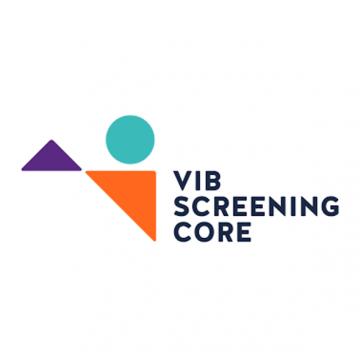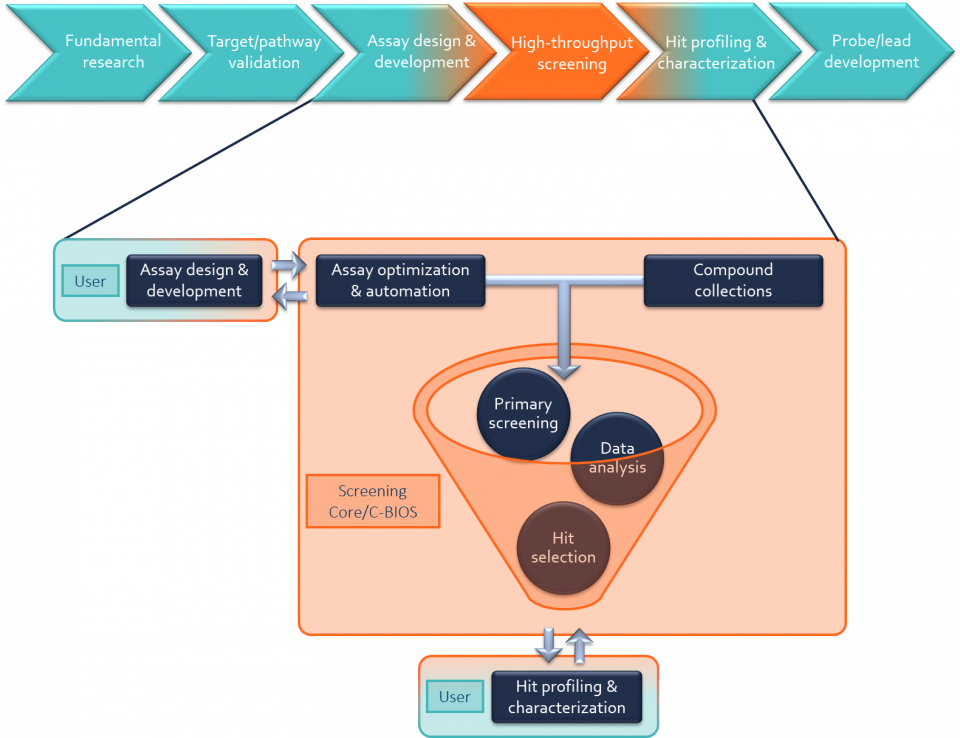VIB Screening Core

Mission
The VIB Screening Core is a centralized VIB core facility that is associated with the Ghent University expertise centre for Bioassay Development and Screening (C-BIOS). The Screening Core/C-BIOS was established thanks to funding from VIB, FWO, the Cancer Research Institute Ghent (CRIG) and Ghent University.
The facility provides support in the discovery of bioactive small molecules and functional genomics screening. The support of the Screening Core/C-BIOS creates opportunities to generate chemical tools for the study of biological processes and to validate targets/modes-of-action for a range of disease areas. These activities can be positioned in the early stages of agro/drug discovery.
Expertise
- High-content imaging: converting microscopic observations into high-content quantitative parameters
- Miniaturizing and automating in vitro biochemical assays and microscopic/functional cellular assays
- Identifying hit compounds/genes via primary screenings in high-throughput mode
- Profiling and characterizing hit compounds/genes via secondary screenings
Screening collections
Compound collections
Drug-like structural diversity collection (Enamine): 20,160 compounds
Pharmacological diversity collection (Enamine): 10,240 compounds
Agro-like structural diversity collection (Enamine): 15,000 compounds
VIB collection, diverse and advanced drug-like collection (Enamine, Chembridge, Molport): 24,000 compounds
- FDA-approved collection (Selleckchem): 2,600 compounds
Bioactive collection (Life Chemicals): 8,000 compounds
Functional genomics collections
Human siGENOME/ON-TARGETplus SMARTpool siRNA library (Horizon Discovery): druggable genome, 7,592 genes
Equipment
Standalone devices
Freedom EVO200 (Tecan) working station for versatile liquid handling applications in a broad range of microtiter plates and labware.
Operetta CLS (Revvity) high-content screening microscope for assay development and low-throughput imaging of fixed or live cells based on fluorescence, brightfield and digital phase contrast. The device is equipped with environmental control for live cell imaging, laser-based autofocus, high power LED excitation and a highly sensitive 4.7 MP sCMOS camera.
Integrated high-throughput high-content screening (HT-HCS) platform
The platform at the Screening Core/C-BIOS integrates microscopy-based high-content imaging and multilabel reader-based detection technologies with a range of plate/liquid handling devices to enable full automation and high-throughput applications. Two different detection devices are integrated in the platform: the Opera Phenix (Revvity) high-content screening microscope and the EnVision Xcite (Revvity) multilabel reader. The Opera Phenix enables medium- to high-throughput acquisition of fluorescence, brightfield and digital phase contrast images. The device is equipped with environmental control for live cell imaging, laser-based autofocus, five excitation lasers and four highly sensitive 4.7 MP sCMOS cameras. The EnVision is used to read-out absorbance, fluorescence or luminescence in homogenous assays. The platform is compatible with in vitro biochemical assays and with microscopic/functional assays in a range of cellular model systems (2D cell cultures, 3D cell cultures, co-cultures, induced pluripotent stem cells, primary cells…), unicellular model organisms and small model organisms (Arabidopsis thaliana, zebrafish…).
Software solutions
CDD Vault (Collaborative Drug Discovery) for compound registry and data management
Columbus and Harmony (Revvity) for image analysis and data storage
Spotfire TIBCO (Revvity) for data visualization
Team
Dominique Audenaert, head of core facility
Andrzej Drozdzecki, senior expert high-throughput screening
Le Son Long Nguyen, senior expert automation and liquid handling
Vera Goossens, senior expert high-content imaging
Sam D’Haeyer, senior technician
